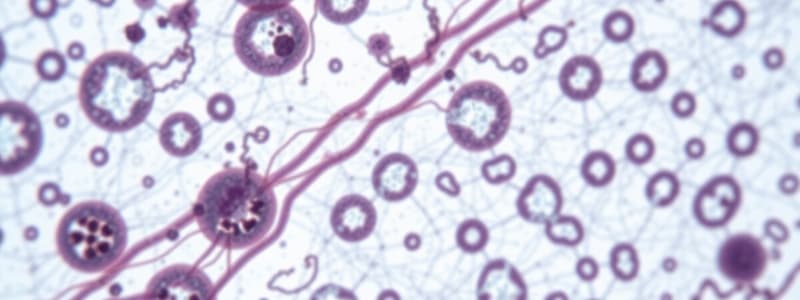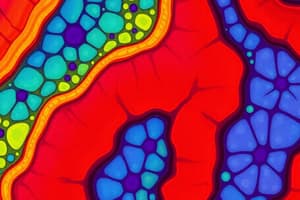Podcast
Questions and Answers
What type of epithelial tissue is found lining the airways and the oviduct?
What type of epithelial tissue is found lining the airways and the oviduct?
- Transitional
- Stratified Columnar
- Stratified Squamous
- Pseudostratified ciliated columnar (correct)
Identify the epithelial tissue responsible for protecting the oral cavity from abrasion while remaining moist.
Identify the epithelial tissue responsible for protecting the oral cavity from abrasion while remaining moist.
- Pseudostratified Ciliated Columnar Epithelium
- Non-Keratinized Stratified Squamous Epithelium (correct)
- Simple Cuboidal Epithelium
- Keratinized Stratified Squamous Epithelium
Which of the following characteristics is NOT a defining factor for epithelial tissues?
Which of the following characteristics is NOT a defining factor for epithelial tissues?
- Highly vascularized (correct)
- Avascular
- Cellularity
- Polarity
What is the primary function of the mucous membrane found in the oral cavity?
What is the primary function of the mucous membrane found in the oral cavity?
Which of the following glands is NOT responsible for producing saliva?
Which of the following glands is NOT responsible for producing saliva?
What type of epithelium is found within salivary glands?
What type of epithelium is found within salivary glands?
What is the key difference between an endocrine gland and an exocrine gland?
What is the key difference between an endocrine gland and an exocrine gland?
Which of the following is an example of an endocrine gland?
Which of the following is an example of an endocrine gland?
Which sequence correctly represents the organization of biological structures from smallest to largest?
Which sequence correctly represents the organization of biological structures from smallest to largest?
What type of epithelium has multiple layers of cells?
What type of epithelium has multiple layers of cells?
Which cell shape is characterized by flat and thin cells?
Which cell shape is characterized by flat and thin cells?
What is the primary function of cilia on the apical surface of epithelial cells?
What is the primary function of cilia on the apical surface of epithelial cells?
Which structure separates epithelial tissue from the underlying connective tissue?
Which structure separates epithelial tissue from the underlying connective tissue?
Which type of epithelial tissue is typically found lining the respiratory tract?
Which type of epithelial tissue is typically found lining the respiratory tract?
What shape of epithelial cells would appear pear-shaped when stretched?
What shape of epithelial cells would appear pear-shaped when stretched?
Which type of epithelial tissue lines the interior of blood vessels?
Which type of epithelial tissue lines the interior of blood vessels?
Flashcards
What type of epithelium moves particles?
What type of epithelium moves particles?
A type of epithelial tissue found in airways and the lining of the oviduct, specialized for moving particles across its surface.
Epithelial tissue characteristics
Epithelial tissue characteristics
Epithelial tissue is characterized by its close arrangement of cells, with a distinct top and bottom, a supportive base, lack of blood vessels, and a remarkable ability to regenerate.
What epithelium lines the oral cavity?
What epithelium lines the oral cavity?
This tissue lines the inside of the mouth, protecting it from abrasion and friction while maintaining moisture.
What epithelium covers the hard palate, tongue, and gums?
What epithelium covers the hard palate, tongue, and gums?
Signup and view all the flashcards
What specific type of epithelium is found in salivary glands?
What specific type of epithelium is found in salivary glands?
Signup and view all the flashcards
What membrane is found inside the oral cavity and what is its lubricant?
What membrane is found inside the oral cavity and what is its lubricant?
Signup and view all the flashcards
Endocrine gland function and example
Endocrine gland function and example
Signup and view all the flashcards
Exocrine gland function and example
Exocrine gland function and example
Signup and view all the flashcards
Tissue
Tissue
Signup and view all the flashcards
Organ
Organ
Signup and view all the flashcards
Epithelial Tissue
Epithelial Tissue
Signup and view all the flashcards
Classification of epithelia
Classification of epithelia
Signup and view all the flashcards
Transitional Epithelium
Transitional Epithelium
Signup and view all the flashcards
Cilia
Cilia
Signup and view all the flashcards
Basement Membrane
Basement Membrane
Signup and view all the flashcards
Simple Squamous Epithelium
Simple Squamous Epithelium
Signup and view all the flashcards
Study Notes
Epithelial Tissue
- Epithelial tissue forms a protective barrier, absorbs, secretes and senses
- It lines body surfaces, cavities, and forms glands
- Three ways to classify epithelia are by number of cell layers, cell shape, and ability to change shape
Classification by Cell Layers
- Simple epithelium: One layer of cells
- Stratified epithelium: Multiple layers of cells
- Pseudostratified epithelium: Appears multilayered but is only one.
Classification by Cell Shape
- Squamous: Flat and thin
- Cuboidal: Cube-like
- Columnar: Rectangular, taller than wide
Epithelial Tissue: Specialized Forms
- Glandular epithelium: Specialized for secretion within glands
- Produces substances like hormones, sweat, and mucus
- Includes endocrine (hormones directly into blood) and exocrine glands (via ducts)
- Ciliated epithelium: Has hair-like cilia on apical surface to move particles (e.g., mucus in respiratory tract)
Epithelial Tissue: Structure
- Basement membrane: Separates epithelium from connective tissue
- Contains basal lamina (collagen/protein) and reticular lamina (fibrous proteins)
Epithelial Tissue: Function
- Protection
- Absorption
- Secretion
- Excretion
- Sensation
Characteristics of Epithelium
- Cellularity: Composed of tightly packed cells
- Polarity: Apical (free) and basal (attached) surfaces with distinct functions
- Supported by connective tissue: Epithelium sits atop a basement membrane
- Avascular: No blood vessels; relies on diffusion for nutrients
- Regeneration: High capacity for cell division and repair
Specific Types and Locations
- Simple squamous epithelium: Lines blood vessels (e.g., capillaries)
- Simple cuboidal epithelium: Lines kidney tubules, salivary glands
- Simple columnar epithelium: Lines digestive tract (absorption)
- Stratified squamous epithelium: Keratinized (tough) lines skin; non-keratinized lines mouth
- Pseudostratified ciliated columnar epithelium: Lines respiratory tract
Additional Notes
- Oral Cavity: Lined by non-keratinized stratified squamous epithelium
- Salivary glands: Contain simple cuboidal epithelium for secretion
- Basement membrane in oral cavity: Mucous membrane containing stratified squamous epithelium, lubricated by saliva produced from salivary glands
Studying That Suits You
Use AI to generate personalized quizzes and flashcards to suit your learning preferences.




